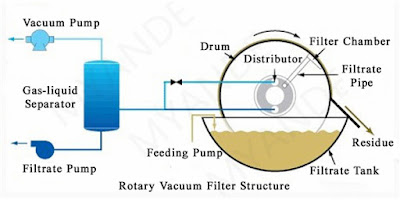In recent years,
corn starch industry has maintained steady growth rate and corn starch processing technology has matured and stabilized. However, protein dewatering
process and equipment used tend to vary from case to case.
In corn wet
milling process, after extraction of germ and fiber, centrifugal separators are
normally used for separation of gluten from starch, yielding thin gluten liquid
of 15-25g/l density. This in turn is thickened by gluten thickener (GT) to
obtain thick gluten liquid of 80~110g/l density. Thick gluten liquid needs to
be further dewatered and dried to yield final commercial gluten powder.
Currently, the rotary vacuum filter (RVF) and plate and frame filter
press are widely used for this application. Another alternative, tried by some
processers, is the decanter centrifuge. The following part of this paper is a brief
comparison between these common protein dewatering methods and related
equipment.
RVF
currently represents the mainstream gluten dewatering equipment for maximum
separation of insoluble gluten from water.
 |
| Rotary Vacuum Filter Structure |
This process is preferable for the
features below:
● Long-time
continuous operation mode.
● High
automation level leading to simplified operation procedure, reduced human
interference in the operation process, and reduced labor cost requirement.
● Clean
production environment as the complete dewatering process takes place inside
the enclosed equipment chamber.
Nevertheless,
the RVF is not free from disadvantages. Moisture content of the discharged material
moisture is relatively higher at 58%~60% and power consumption is comparatively
higher.
2. Plate
and Frame Filter Press
The
plate and frame filter press came into use earlier than rotary vacuum filter
and is currently still used in some starch factory for gluten dewatering
process.
The most
obvious advantages of plate and frame filter press is the relatively lower
moisture content in the discharged material at 50%~55% and lower power
consumption.
 |
| Plate and Frame Filter Press |
The negative
side of plate and frame filter press is:
● Incapable
of continuous operation as it relies on pressure, which needs to be maintained
for some time, to remove water from protein. The solution is to use multiple
units in parallel.
● Intense
work load for the operator for moving plates apart and cleaning the cloth.
Although mechanical plate parting devices have been tried, human interference
in this process is still required.
● Undesirable
working environment due to scattering of protein particles on the operation
platform.
About 10 years
ago, some corn starch processors started experiment with decanters with little
success. In recently years, with the progress of technology, decanters are
again used for protein dewatering.
 |
| Decanter Centrifuge Structure |
The decanter
centrifuge has the following advantages:
● Smaller
operation space requirement than RVF and plate & frame filter.
● Capability
of continuous operation.
● High
level of automation and lower labor intensity.
● Clean
and hygienic operation without pollution caused by scattering of protein and
acid gas.
On
the other hand, decanter dewatering application requires addition of chemicals
into the thick gluten liquid. There is so far little sure evidence for its
watering effect even though some manufacturers assure that the moisture content
of the discharged material will be at 55~58%.
Conclusion: From the above
comparison, it can be concluded that each of these three methods has pros and
cons. The choice depends on comprehensive consideration of various factors that
include availability of workshop space, initial investment, cost of steam,
electricity and labor, cost of consumables, operation environment, and
user-friendliness. Currently, most corn starch processors in China opt for RVF
for this application.